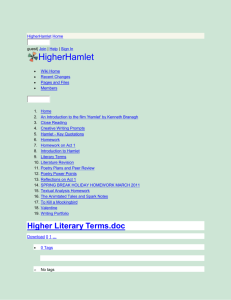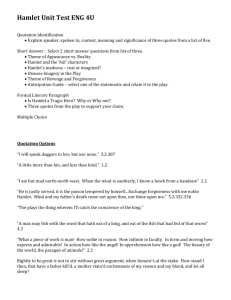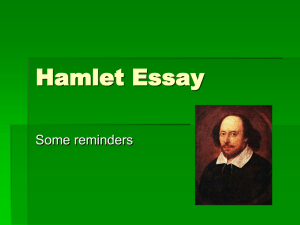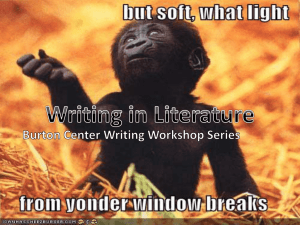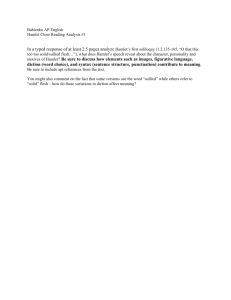Final Exam REVIEW ppt
advertisement
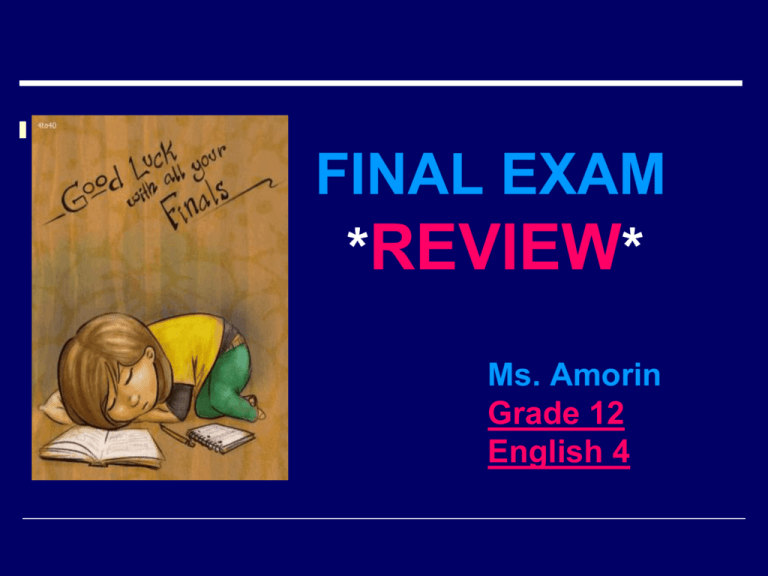
FINAL EXAM *REVIEW* Ms. Amorin Grade 12 English 4 Format of Final Exam Poem: multiple choice questions, open ended question response Multiple choice questions from content/lessons covered in class (many are “play” related) Résumé format questions (multiple choice) Works Cited format (MLA) ESSAY* Part 1- POETRY Reading and analyzing poetry Consider the “Elements of Poetry” from previous class notes: Subject Narrator Diction Tone Rhythmical devices Literary devices Values/ Theme Literary Terms Simile- compare two seemingly unalike nouns using the words "like" or "as". Onomatopoeia- spelling out a sound Alliteration- repetition of initial consonant sounds Metaphor- compare two seemingly unalike nouns without "like" or "as". Literary Terms Symbol- An object or idea that represents something with significance. Personification giving human-like qualities to an object or idea. Theme-the author's central purpose; message to audience which exemplifies a lesson Hyperbole- is an extreme exaggeration used for humor or to make a point. Part 2: Open- Ended Question Response Thoroughly answer open-ended questions using specific examples and “quotes” from reading selection or lines in poetry as supportive evidence. Keep the following tips in mind. R- Re-state the stem in your own words (include author and “title” of reading selection) A- Answer all the bullet questions (one paragraph for each bullet written in complete sentences) C- Cite information (use supporting details from the reading selection to support response; include “quotes” from reading) E- Edit and end response. Sum up ideas or draw a connection at the end (relating new to known) Model Open-Ended (format) STEM- (re-state in own words; include Title and author) “Quantity, Not Quality” examines the misuse/ overuse of technological advances. Therefore, the “gift” the father had given his daughter was not as helpful as he had expected it to be. Bullet QUESTIONS (answer in complete sentences; one paragraph for each bullet. Include specific examples from selection and “quotes” as supportive evidence) What is the “gift” the author says her father gave his children? Why does the author see her father’s actions as a gift? Add a closing (Either wrap up main points from bullet questions or draw a connection (relating new to known) Part 3: Literary terms READING* Existentialism- philosophy that emphasizes personal responsibility and an indifferent world (the idea of “existence”- one’s worth) Ex.) The Stranger or Hamlet Protagonist- main character (“good guy”) who has a character flaw that ruins/ defects their character/ reputation Ex.) Othello Antagonist- “bad guy” who works against the protagonist- (opposes the protagonist) Ex.) Iago or King Claudius Literary terms READING* cont... FOIL- Characters that share several similarities yet one character contrasts from the other character based on a specific character trait Ex.) Hamlet/ Fortinbras Soliloquy- when a character reveals their inner thoughts, feelings, and intentions to a silent audience Ex.) Iago in Othello Elements of a Play* (keep Shakespeare plays in mind) Exposition- the background information in a literary piece (time, location, setting, characters) Exciting force- is the moment that follows the introduction of a drama and initiates the rising action; reveals the essence of the plot Ex.) In Hamlet, the exciting cause is the Ghost's announcement of his murder to Hamlet, followed by a command to take revenge; the exciting force is Hamlet's resolution to avenge his father's murder. Elements of a Play* cont… (keep Shakespeare plays in mind) Climax- a decisive moment that is of maximum intensity or is a major turning point in a plot. Falling action- the part of a literary plot that occurs after the climax has been reached and the conflict has been resolved. Ex.) In Othello, the truth about Iago’s villainy is exposed by Emilia when she understands the symbolism behind what the handkerchief was used for. Resolution- the conclusion; the end result; the lesson to be learned Elements of a Play* cont… (keep Shakespeare plays in mind) IRONY- The use of words to express something different from and often opposite to their literal meaning; contradiction Situational irony- irony involving a situation in which actions have an effect that is opposite from what was intended, so that the outcome is contrary to what was expected. Verbal irony- a person says or writes one thing and means another, or uses words to convey a meaning that is the opposite of the literal meaning. *Dramatic irony- when the words and actions of the characters of a work of literature have a different meaning for the reader than they do for the characters. Ex.) Prince Hamlet insults Polonius indirectly (rat- weasel); the reader understands the idea that is being conveyed, but the character does not Ex.) Prince Hamlet “acting mad” throws off characters; the reader knows this but other characters do not Tragic hero A tragic hero is a heroic main character (protagonist) of a tragedy whose life is brought to ruin due to a character flaw. A character flaw is an admirable quality that turns into an imperfection. When “used” inappropriately, it can lead to the downfall of both the main character and others in his/ her surroundings. ex.) loyalty, trust, jealousy, love, etc… William Shakespeare Born and died on same day- April 23 Known as best English writer in history (plays and poems) Recognized for works such as Hamlet, Othello, Taming of the Shrew, and Romeo and Juliet Wrote his works in the Elizabethan time period Part 4: Writing a Résumé Look over notes and models given in class (*different components for different sections) See “RÉSUMÉ” Power Point on E-Board from class lessons Critical components of a résumé include: Objective* Education Work Experience* Skills* MLA Citations What does MLA stand for? Modern Language Association How does one properly cite research/ quotes, statistics, etc… using an in-text citation?? Ex.)_____________ (Martell 4). (Author’s last name and pg 3 in parenthesispunctuation after citation)*** OR Ex.)_______________ (College Life 21). (Title of article- italicized or in “quotes” if author is unavailable with pg. #) MLA CITATION Website article Model Author’s last name, First. “Title of Article.” Title of Website Copyright date. Date of visitation to website. <web address> Ex.) Lawson, Katie. “January is Volunteer Blood Donor Month.” American Red Cross 24 Jan. 2006. 13 March 2011. <http://www.redcross.org/article/010720.html> MLA CITATION Book Model Author’s last name, First. Title of Book. Location of Publication: Publisher, Copyright date. Example) Garcia, Maria. The Truth Behind Columbus’s Voyage. Brooklyn, New York; Marcellus Enterprises, 2010. ESSAY* (50 points) Review NOTES/ quizzes, class assignments on: Hamlet* Othello* And short stories from Textbook Units (Review- characters, setting, plot, conflict, climax, falling action, tragedy) Format of Final Exam Poem: multiple choice questions, open ended question response Multiple choice questions from content/lessons covered in class (many are “play” related) Résumé format questions (multiple choice) Works Cited format (MLA) ESSAY* GOOD LUCK!! Best Wishes in the future! Work hard and be motivated to succeed! Fortune Favors the Bold! CHS
